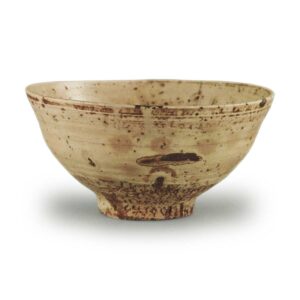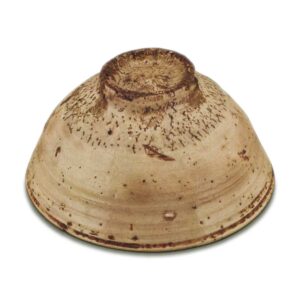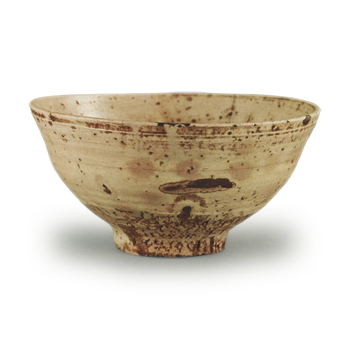

Chuko Meibutsu
Height: 7.1-7.4cm
Diameter: 14.5-14.9cm
Outer diameter of foot ring: 5.3-5.5cm
Height: 0.7cm
The name comes from the fact that it was owned by Araki Shinbei, a well-known Chinese antique dealer in Kyoto during the Momoyama and early Edo periods. Shinbei was a member of the Itowakifuda, or trading guild, in Kyoto, and is said to have learned the tea ceremony from Enshu and had tea utensils made to his own taste at pottery kilns in Shigaraki, Mino Seto, Bizen, etc. He was known as a leading tea ceremony enthusiast of the time.
The overall shape is rather thin, with a finely-turned wheel mark, and the bowl is shaped like a bowl, with a slightly upturned rim. The entire body below the waist is chamfered, but the chamfering around the foot is relatively shallow. However, the foot of the bowl, which is shaped like a bamboo joint, is quite forceful and is a key feature of this tea bowl. The inside of the bowl is slightly concave, but the thickness from the bottom to the waist is quite thick. The foot of the bowl is unglazed, and because of the dirt on it, it looks like a color similar to that of decaying leaves, but it is actually a grayish-white color. The entire interior and exterior is covered in a bluish white glaze, but within this, there are faintly scattered light grayish brown spots of various sizes, creating a scene of great depth. Furthermore, the glaze on the foot of the cup is applied over the scraped surface of the clay body, giving it a unique texture with a crinkled finish that extends to the foot of the cup, and when combined with the style of the foot itself, it gives the cup a dignified appearance. There is a single character-shaped mark on the upper body that appears to be a sticking mark, and there is also a sticking mark under the rim that looks like a stone flap.
Overall, both the body and the glaze are quite hard and tightly fired, and it can truly be called a hard-handled teacup. However, it is not pure porcelain like the Nagasaki hard-handled teacups, nor is it as soft as the so-called rain-leak teacups. It could be said to be a hard-handled teacup that is soft enough to develop rain-leak-like stains.
The two characters “Arai” on the inside of the lid were written by Kobori Masataka, the son of Enshu, also known as Jūzaemon, and the paper on the inside of the lid, which says “Sohaku tea bowl hand”, is said to have been written by Tsuchiya Masanao, the lord of the Tsuchiya clan and lord of the Tsuchiya clan, who died in November 1722 at the age of 82.
In addition, the “Tsuchiya Kura-cho” inventory of the collection contains the following entry: “From the era of the Arirai Koryo well, with a crack, a tea bowl with a bag-shaped ground and a donzu finish. With a box-shaped paulownia wood label, written by Kobori Jūzaemon-dono. In addition, the entry ‘Iga-sama’ is written in red ink.
It is also listed in the “Meibutsu-ki” and “Kokin Meibutsu Ruiju”, but the description in the “Meibutsu-ki” is “Arai tea bowl, a leak-proof, old-fashioned tea bowl of the Kokin era, owned by Tsuchiya Samon, inspected on the 18th of the 5th month of the 8th year of the Tenmei era (omitted below) (the rest is omitted)”, and the measurements, box and bag are all noted, and the ‘Sohaku tea bowl hand’ label on the underside of the lid is also attributed to Tsuchi Soshū. Accordingly, it was in the possession of Tsuchiya Sagami no Kami Masanao, then passed to Matsudaira Iga no Kami, and then to Kawamura Den’ei, one of the Ten Great Edo Tea Masters, and on October 17th, 1891, it was sold at auction by the Kawamura family for 400 yen and entered the Umakoshi family.
In the “Great In the Taisho Meiki Kan, this tea bowl is referred to as a sobaku-te (white-glazed tea bowl), perhaps out of respect for the label “sobaku-te” on the tea bowl, but sobaku is a type of tea bowl with a powdered glaze, and the white glaze is not a powdered glaze



